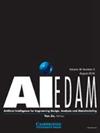Prediction of the onset of shear localization based on machine learning
IF 2.3
3区 工程技术
Q3 COMPUTER SCIENCE, ARTIFICIAL INTELLIGENCE
Ai Edam-Artificial Intelligence for Engineering Design Analysis and Manufacturing
Pub Date : 2023-06-08
DOI:10.1017/S0890060423000136
引用次数: 0
Abstract
Abstract Predicting the onset of shear localization is among the most challenging problems in machining. This phenomenon affects the process outputs, such as machining forces, surface quality, and machined part tolerances. To predict this phenomenon, analytical, experimental, and numerical methods (especially finite element analysis) are widely used. However, the limitations of each method hinder their industrial applications, demanding a reliable and time-saving approach to predict shear localization onset. Additionally, since this phenomenon largely depends on the type and parameters of the constitutive material model, any change in these parameters requires a new set of simulations, which puts further restrictions on the application of finite element modeling. This study aims to overcome the computational efficiency of the finite element method to predict the onset of shear localization when machining Ti6Al4V using machine learning methods. The obtained results demonstrate that the FCM (fuzzy c-means) clustering ANFIS (adaptive network-based fuzzy inference system) has given better results in both training and testing when it is compared to the ANN (artificial neural network) architecture with an R2 of 0.9981. Regarding this, the FCM-ANFIS is a good candidate to calculate the critical cutting speed. To the best of the authors’ knowledge, this is the first study in the literature that uses a machine learning tool to predict shear localization.基于机器学习的剪切局部化开始预测
摘要预测剪切局部化的开始是机械加工中最具挑战性的问题之一。这种现象会影响加工输出,如加工力、表面质量和加工零件公差。为了预测这种现象,分析、实验和数值方法(尤其是有限元分析)被广泛使用。然而,每种方法的局限性都阻碍了它们的工业应用,需要一种可靠且省时的方法来预测剪切局部化的开始。此外,由于这种现象在很大程度上取决于本构材料模型的类型和参数,这些参数的任何变化都需要一组新的模拟,这进一步限制了有限元建模的应用。本研究旨在克服有限元方法在使用机器学习方法加工Ti6Al4V时预测剪切局部化开始的计算效率。结果表明,与R2为0.9981的人工神经网络结构相比,FCM(fuzzy c-means)聚类ANFIS(adaptive networked fuzzy inference system)在训练和测试方面都取得了更好的结果。关于这一点,FCM-ANFIS是计算临界切削速度的一个很好的候选者。据作者所知,这是文献中第一项使用机器学习工具预测剪切局部化的研究。
本文章由计算机程序翻译,如有差异,请以英文原文为准。
求助全文
约1分钟内获得全文
求助全文
来源期刊
CiteScore
4.40
自引率
14.30%
发文量
27
审稿时长
>12 weeks
期刊介绍:
The journal publishes original articles about significant AI theory and applications based on the most up-to-date research in all branches and phases of engineering. Suitable topics include: analysis and evaluation; selection; configuration and design; manufacturing and assembly; and concurrent engineering. Specifically, the journal is interested in the use of AI in planning, design, analysis, simulation, qualitative reasoning, spatial reasoning and graphics, manufacturing, assembly, process planning, scheduling, numerical analysis, optimization, distributed systems, multi-agent applications, cooperation, cognitive modeling, learning and creativity. AI EDAM is also interested in original, major applications of state-of-the-art knowledge-based techniques to important engineering problems.

 求助内容:
求助内容: 应助结果提醒方式:
应助结果提醒方式:


